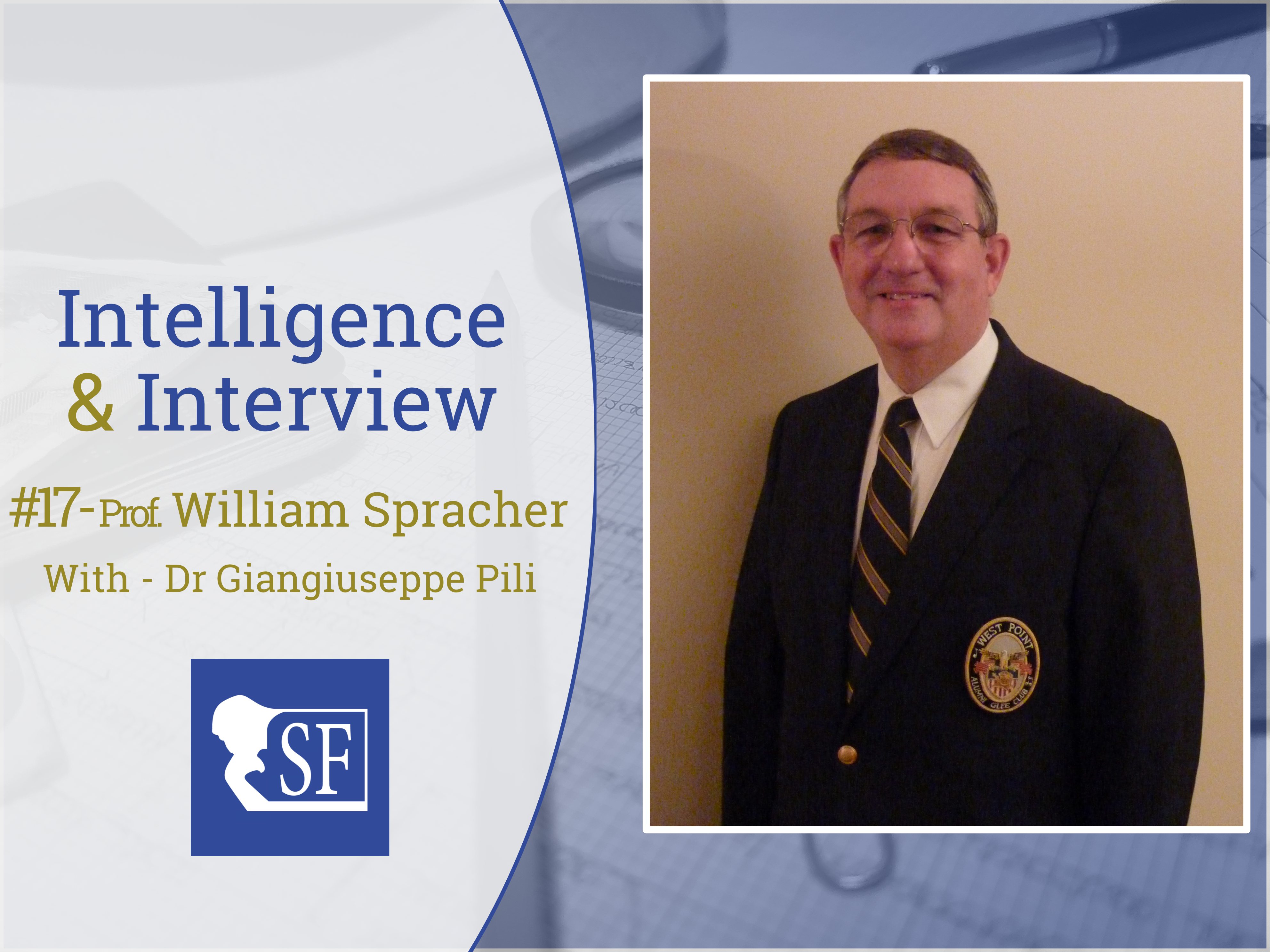
“Intelligence & Interview” #17 is honored to present you a wonderful interview with an exceptional guest, Dr. William Spracher, Professor of Strategic Intelligence and Director of the Writing Center at the National Intelligence University! The first time I saw Professor Spracher, he didn’t know it. It was my first time at the International Studies Association convention in Baltimore, 2017. It looks like an age ago, and it was my first engagement with the Intelligence Studies Section (ISS). I was intimidated, and I used to listen carefully, silently. Since then, I had the pleasure of participating in ISA regularly, and Professor Spracher was always there. However, the first time we spoke was due to a wonderful opportunity Professor Spracher was advertising: a student volume to be edited by the American Intelligence Journal. I kindly asked him if it was a sound idea to advertise it a bit. And I did it. Moreover, I had the pleasure to meet Professor Spracher again at the International Association for Intelligence Education (IAFIE) conference (2019) in New York. It was one of the best conferences I ever attended. I confess that I really enjoyed it. In addition, it was my first time in NY, and it was an overwhelming experience. Professor Spracher was present to my panel, where I presented one of my well-known (maybe not) “crazy” research. It was a comparison between chess and intelligence. Then, I submitted it to the American Intelligence Journal, whose editor in chief is Professor Spracher himself. It is my fifth article in an international journal, “Is a Chess Player and Intelligence Analyst?” (American Intelligence Journal, 36: (2), 74-85). Professor Spracher is a very dedicated and inspiring person whose experience in the field of intelligence education, intelligence tradecraft, and so much more is well-known. Then, it is with my distinct pleasure to publish the interview on Scuola Filosofica – for those who don’t know it yet, is one of the leading cultural blogs in Italy. In the name of Scuola Filosofica Team, our readers, and myself, Giangiuseppe Pili, William: thank you!
1. Professor William Spracher, let’s start from the basics. How would you like to present yourself to the International readers and Philosophical School (Scuola Filosofica)?
I am Dr. William C. Spracher, but I go by the nickname “Bill.” I am a Professor of Strategic Intelligence and Director of the Writing Center at the National Intelligence University in Bethesda, Maryland, USA, where I have worked for nearly 17 years and from which I first graduated as a young Army officer back in 1977 (then known as the Defense Intelligence School, located in Washington, DC). I retired as a colonel in 2000 and served for three decades in the Army’s Military Intelligence branch and as a Foreign Area Officer specializing in Latin America. In that role, I was able to reach my highest goals as an intelligence officer interested in foreign affairs—to work for an overseas combatant command (J2, U.S. Southern Command in Panama), to serve as a military attaché in that region (Peru and Colombia), and to teach regional and intelligence subjects to allied civilian and military personnel (as Military Professor at the William J. Perry Center for Hemispheric Defense Studies, National Defense University, in Washington, DC).
2. What do you think intelligence education is about? Is intelligence teaching more about training or a broader understanding of intelligence (e.g., history, case studies, etc.)?
I think intelligence education is much broader than merely training or what many refer to as “intelligence studies,” which has traditionally focused mainly on analysis. Intelligence education includes any aspect of education that contributes to making an individual a better intelligence officer, which could include such fields as political science, economics, history, foreign languages, international relations, and the law, plus others. I outlined this clearly in my 2009 doctoral dissertation at George Washington University which was titled “National Security Intelligence Professional Education: A Map of U.S. Civilian University Programs and Competencies.” Training in intelligence, like training in anything, teaches an individual a skill and how to apply that skill to a particular problem, replicating success through repetition. Education is much broader and long-term in its focus. It teaches an individual not what to think, but how to think. It fosters critical thinking, creative thinking, and the application of skills learned through training to more general, long-range problems that pull from all fields of knowledge.
3. What do you think the students of intelligence need the most today? Do the current courses offered by the universities meet the average expectations? Is the academic response to the market’s demands actually good, or it has to be improved?
The intelligence students of today need to know how to conduct analysis, using logic, reasoning, and structured analytic techniques; how to communicate effectively, both in writing and orally, because the best analysis in the world is worthless if not communicated effectively to the consumer; how to mitigate political opinions and biases and assess a problem in an objective way; and how to tap the robust resources at their disposal, to include human resources in dealing with both domestic colleagues and international counterparts and logistical, financial, and data resources.
In the United States, academic offerings in the field of intelligence are largely driven by the market, though there are some exceptions. In the wake of the attacks on 9/11, and the perceived failures of the U.S. intelligence system to forecast them, the demand for “intelligence studies” offerings, or education and training related strictly to intelligence, homeland security, and law enforcement, rose precipitously. This demand was spurred by such legislation as the Intelligence Reform and Terrorism Prevention Act of 2004, the formation of the Office of the Director of National Intelligence, the establishment of the Department of Homeland Security, the rapid hiring of more counterterrorism analysts to fill suddenly beefed-up agencies (or those with new missions, such as the FBI), and other developments. Quite a few of the individuals hired to teach these courses were recently retired senior officials who yearned to continue mentoring young people by serving as adjunct faculty members and developing elective courses tailored to their narrow portfolios. This thirst for more intelligence and national security courses at the graduate and undergraduate level was still not fully quenched by the time I was working on my doctoral dissertation on intelligence education, as I found scores of universities were quickly starting up individual courses, entire programs, majors and minors, certificates, and every other sort of approach in an attempt to quench this thirst. I found a wide variety in terms of quantity and quality from one campus to another.
Frankly, I believe some schools started up programs just because this was a “hot topic” and they figured it was good for business. The noted intelligence scholar Dr. Mark Lowenthal, who has been both a high-level practitioner and an academic, told me that he felt some of them were just trying to take advantage of the trend and “put butts in the seats” (which generates easy dollars in tuition). He and I agreed that some courses at less-than-stellar schools reflected tantalizing titles that might attract students looking for a job much like a James Bond movie would attract teenagers looking for adventure back in the last century. Some course titles suggested subject matter that could only be taught properly at the classified level, as is done where I teach at the National Intelligence University, while marketing to students that they might get more in depth into clandestine and covert aspects of the profession than they would if they attended other schools.
There was fierce competition to attract students, and federal dollars were available to some colleges, especially those serving minority populations, under the IC-CAE program (Intelligence Community Centers of Academic Excellence), which emerged in 2005. Some schools have adhered primarily to teaching intelligence tradecraft, such as analysis, while others have taken a more all-encompassing approach, teaching related subjects within history, political science, or international relations fields that view intelligence as just one arrow in the quiver of instruments of national security policy and decision-making. Lowenthal is fond of saying that U.S. intelligence and security agencies would prefer to hire young people who know “something about something,” i.e., a substantive subject, not just how to do analysis. He would insist that they must have a deep pool of knowledge about the issues they are asked to analyze. If they are analyzing a foreign threat, for example, and all they were taught was how to apply a particular structured analytic technique, without any knowledge of the culture, language, politics, economics, or military capacity of the adversary, what good is it? How sound will their analysis really be?
My impression is that the rush to set up intelligence offerings in the U.S. has slowed somewhat in the last five years or so, as universities have conducted cost-benefit analyses and canvassed recent graduates who may have done well in their intelligence programs but still have trouble securing a meaningful job in the Intelligence Community. The pace has slowed, and the thrust has moved away from preparing students mainly to be counterterrorism analysts to helping them develop in other areas as well.
As I suggested in my other responses, intelligence is more than just analysis, and intelligence education is more than just preparing a student to be a full-time analyst. He/she might also need to prepare for other roles, such as operator, collection manager, case officer, branch/division chief, trainer, professor, linguist, interpreter/translator, briefer, advisor, etc. The need for a more well-rounded education than just intelligence studies is now gaining currency in the United States. Perhaps that means the U.S. is getting back closer to the approach taken by its European allies. Intelligence education can always be improved. It seems to me that, compared to the somewhat frightening 2000s, U.S. intelligence educators are now emphasizing quality over quantity, and that is a good thing.
4. How do you see the education of intelligence in the future? Is it going to be more standardized?
It may become a bit more standardized as teachers and practitioners interact more closely with each other and share best practices. One forum through which this is occurring is a professional organization known as the International Association for Intelligence Education, founded in 2004, for which I currently serve as Vice President and previously served on both its Educational Practices Committee and as president of its Washington Area Chapter. Members of IAFIE and other organizations, such as the Intelligence Studies Section of the International Studies Association and the National Military Intelligence Foundation, hold events which facilitate interchange among those involved in intelligence education. Items such as course syllabi, case studies, teaching techniques, and bibliographies are shared, which means the individual professors and schools involved in intelligence education may start to mirror each other more than in the past. However, complete standardization will never occur because there is so much diversity in student populations, geographic regions, classification levels at which courses can be taught, legal and educational frameworks, substantive priorities/focuses of different institutions, and other factors.
5. Let’s consider now the American Intelligence Journal(AIJ) (for which I proudly published a paper on chess and intelligence). What is its mission, and how does it pursue it?
The American Intelligence Journal is the principal publication of the National Military Intelligence Foundation, and before 2017 of its predecessor organization the National Military Intelligence Association. Its mission is to inform the readers of the Journal about issues affecting the practice of military intelligence, mainly at the strategic level; the intelligence enterprise in general; national/international security; and homeland security and law enforcement. It also is designed to promote publishing of research by both seasoned professionals in the enterprise and also young students who are preparing to serve within the Intelligence Community, both those from the U.S. and those from other nations. For instance, the most recent issue of AIJ (Vol. 37, No. 1, 2020) was reserved for articles and book reviews by students only. Its theme was “Intelligence Community Leadership: The Next Generation.” Students have been published in the Journal in the past, but this was the first-ever issue dedicated solely to promoting the work of students.
6. AIJ has a long history, especially considered how young is the intelligence literature. Very briefly, can you give us the historical flavor in which AIJ was founded and evolved?
AIJ has been publishing twice a year since about 1978, only four years after its parent organization, the National Military Intelligence Association, was founded in 1974. It began as the brainchild of the NMIA Executive Director at the time, COL (USA, Ret) Charles Thomann, who almost single-handedly began evolving the Journal from being a fairly short, magazine-like publication focused heavily on tactical intelligence, and most of that Army-centric, into the lengthy, scholarly, academic journal it is today. In the early days, almost all the authors were military personnel who were also members of NMIA, which although all along was joint (i.e., all military services represented), was heavily focused on the Army. In fact, the inaugural president of NMIA was the legendary Army LTG Vernon Walters, famous as a special envoy and interpreter for several U.S. presidents, Deputy/Acting Director of Central Intelligence during the turbulent Watergate era and subsequent investigations of intelligence abuses by various agencies, and U.S. Ambassador to the United Nations and later to the Federal Republic of Germany.
7. Who are the main writers and readers of AIJ?
Nowadays the writers of AIJ represent a broad population of both U.S. and foreign personnel, most of whom were never dues-paying members of NMIA or financial contributors to NMIF. Approximately half are active-duty or retired military personnel; the rest are civilians. Many are current or former practitioners of intelligence, but quite a few are academics and students. The readers represent a similar audience, i.e., a mixture of military and civilian personnel primarily from the U.S. but increasingly from other countries. Many authors and book reviewers are colleagues of this editor met during events hosted by other professional organizations, who learned about AIJ and see it as a viable publishing outlet for their research. They realize it will give them exposure to a broad audience of readers interested in intelligence and national security who are excited to learn about their innovative ideas and comprehensive research on issues of critical importance to all.
8. What is the main difference between AIJ and other intelligence journals such as Intelligence and National Security or the International Journal of Intelligence and CounterIntelligence?
These two journals are both highly respected within the international intelligence community. They are recognized as peer-reviewed, scholarly journals whose editorial boards boast some of the biggest names in the intelligence business. Both utilize the common peer review process of multiple blind reviewers evaluating manuscripts presented anonymously. However, this process is time-consuming, complicated, and even intimidating for many budding writers, especially young ones just starting out in their careers. On the other hand, AIJ is produced by a barebones editorial element, in which the editor (Dr. Spracher) is an unpaid volunteer who has a separate full-time job as a professor. His layout/production assistant for producing the Journal is the only paid employee of NMIF and has other administrative tasks separate from working on that product. Even though we consider AIJ as being “peer-reviewed,” in that the editor has to submit the proposed slate of articles to the board of directors of NMIF for its approval of what is being published, in most cases the board members defer to the editor’s discretion on his recommendations of what articles are timely, well-written, and appropriate for consumption by the Journal’s audience. Often he recommends to potential authors other publishing outlets, such as INS and IJIC, that might be more appropriate for their manuscript. Because of the more streamlined approval process for AIJ, authors usually can get their research published more quickly and easily than with the other journals.
9. Is AIJ interested in new proposals? If so, how can our readers reach the journal?
Absolutely. Interested personnel should contact the editor by email at AIJEditor@nmif.org or spracherw@yahoo.com.
10. How can our readers follow you and AIJ?
Readers are encouraged to go to the NMIF website at www.nmif.org and click on “Publications,” where recent issues of AIJ are posted. There is also information on the site about the many other activities of NMIF, such as its extensive scholarship program.
11. Five keywords that represent you?
Intelligence officer, educator, regional expert, writer, editor




Be First to Comment